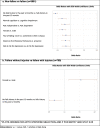Incidence of falls and fall-related injuries and their predictive factors in frail older persons with cancer: a multicenter study
- PMID: 36402961
- PMCID: PMC9675153
- DOI: 10.1186/s12877-022-03574-7
Incidence of falls and fall-related injuries and their predictive factors in frail older persons with cancer: a multicenter study
Abstract
Background: Falls and fall-related injuries are a major public health problem. Data on falls in older persons with cancer is limited and robust data on falls within those with a frailty profile are missing. The aim of this study is to investigate the incidence and predictive factors for falls and fall-related injuries in frail older persons with cancer.
Methods: This study is a secondary data analysis from data previously collected in a large prospective multicenter observational cohort study in older persons with cancer in 22 Belgian hospitals (November 2012-February 2015). Patients ≥70 years with a malignant tumor and a frailty profile based on an abnormal G8 score were included upon treatment decision and evaluated with a Geriatric Assessment (GA). At follow-up, data on falls and fall-related injuries were documented.
Results: At baseline 2141 (37.2%) of 5759 included patients reported at least one fall in the past 12 months, 1427 patients (66.7%) sustained an injury. Fall-related data of 3681 patients were available at follow-up and at least one fall was reported by 769 patients (20.9%) at follow-up, of whom 289 (37.6%) fell more than once and a fall-related injury was reported by 484 patients (62.9%). Fear of falling was reported in 47.4% of the patients at baseline and in 55.6% of the patients at follow-up. In multivariable analysis, sex and falls history in the past 12 months were predictive factors for both falls and fall-related injuries at follow-up. Other predictive factors for falls, were risk for depression, cognitive impairment, dependency in activities of daily living, fear of falling, and use of professional home care.
Conclusion: Given the high number of falls and fall-related injuries and high prevalence of fear of falling, multifactorial falls risk assessment and management programs should be integrated in the care of frail older persons with cancer. Further studies with long-term follow-up, subsequent impact on cancer treatment and interventions for fall prevention, and integration of other important topics like medication and circumstances of a fall, are warranted.
Trial registration: B322201215495.
Keywords: Cancer; Fall-related injuries; Falls; Frailty; Geriatric assessment; Older persons.
© 2022. The Author(s).
Conflict of interest statement
The authors declare that they have no competing interests.
Figures



Similar articles
-
[Impact of fall risk and fear of falling on mobility of independently living senior citizens transitioning to frailty: screening results concerning fall prevention in the community].Z Gerontol Geriatr. 2007 Aug;40(4):255-67. doi: 10.1007/s00391-007-0473-z. Z Gerontol Geriatr. 2007. PMID: 17701116 German.
-
Fall predictors in older cancer patients: a multicenter prospective study.BMC Geriatr. 2014 Dec 15;14:135. doi: 10.1186/1471-2318-14-135. BMC Geriatr. 2014. PMID: 25511244 Free PMC article.
-
Frailty and Fear of Falling: The FISTAC Study.J Frailty Aging. 2017;6(3):136-140. doi: 10.14283/jfa.2017.19. J Frailty Aging. 2017. PMID: 28721429
-
Risk factors for falls in older people with pre-frailty: A systematic review and meta-analysis.Geriatr Nurs. 2025 Mar-Apr;62(Pt A):272-279. doi: 10.1016/j.gerinurse.2024.10.030. Epub 2024 Nov 9. Geriatr Nurs. 2025. PMID: 39521661
-
A systematic review of fall prevention interventions in frail older adults.Geriatr Nurs. 2025 Mar-Apr;62(Pt B):236-244. doi: 10.1016/j.gerinurse.2025.02.018. Epub 2025 Mar 6. Geriatr Nurs. 2025. PMID: 40054127
Cited by
-
Improved accuracy and efficiency of primary care fall risk screening of older adults using a machine learning approach.J Am Geriatr Soc. 2024 Apr;72(4):1145-1154. doi: 10.1111/jgs.18776. Epub 2024 Jan 13. J Am Geriatr Soc. 2024. PMID: 38217355 Free PMC article.
-
Chemotherapy-Induced Peripheral Neuropathy and Falls in Cancer Survivors Relate to Digital Balance and Gait Impairments.JCO Precis Oncol. 2024 Jun;8:e2300312. doi: 10.1200/PO.23.00312. JCO Precis Oncol. 2024. PMID: 38885463 Free PMC article.
-
Falls and fall-related injuries: prevalence, characteristics, and treatment among participants of the Geelong Osteoporosis Study.Front Public Health. 2024 Oct 18;12:1454117. doi: 10.3389/fpubh.2024.1454117. eCollection 2024. Front Public Health. 2024. PMID: 39494080 Free PMC article.
-
Frequency, Characteristics, and Risk Factors for Falls at an Inpatient Cancer Rehabilitation Unit.JCO Oncol Pract. 2023 Sep;19(9):741-749. doi: 10.1200/OP.23.00188. Epub 2023 Jun 20. JCO Oncol Pract. 2023. PMID: 37339393 Free PMC article.
-
The relationship between frailty and depression in Chinese elderly prostate cancer patients following radical surgery: the mediating effect of sleep disturbances.Support Care Cancer. 2025 Mar 24;33(4):315. doi: 10.1007/s00520-025-09374-0. Support Care Cancer. 2025. PMID: 40122931
References
-
- Lamb SE, Jørstad-Stein EC, Hauer K, Becker C. Development of a common outcome data set for fall injury prevention trials: the prevention of falls network Europe consensus. J Am Geriatr Soc. 2005;53(9):1618–1622. - PubMed
-
- Hauer K, Lamb SE, Jorstad EC, Todd C, Becker C. Systematic review of definitions and methods of measuring falls in randomised controlled fall prevention trials. Age Ageing. 2006;35(1):5–10. - PubMed
-
- WHO Global Report on Falls Prevention in Older Age. https://www.who.int/ageing/publications/Falls_prevention7March.pdf?ua=1. Accessed 23 Apr 2021.
-
- Tinetti ME, Speechley M, Ginter SF. Risk factors for falls among elderly persons living in the community. N Engl J Med. 1988;319(26):1701–1707. - PubMed
-
- Rubenstein LZ. Falls in older people: epidemiology, risk factors and strategies for prevention. Age Ageing. 2006;35 Suppl 2:ii37–ii41. - PubMed
Publication types
MeSH terms
LinkOut - more resources
Full Text Sources
Medical
Miscellaneous

